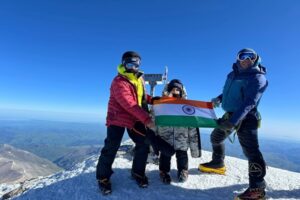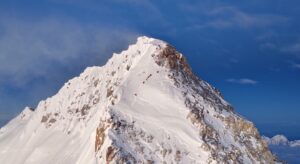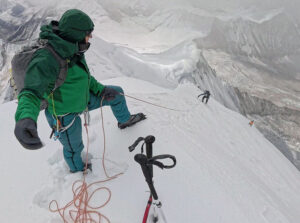This season, Everest is again the center of attention, and again, not for positive reasons. Of over 600 summits, only two were without supplementary oxygen. Two other people who attempted the feat died trying.
News has focused on rescues, stolen gear, garbage in Camp 4, and potentially a record number of deaths on a mountain that should be safer than ever.
According to Nepali media, there are 17 people confirmed dead, but climbers and outfitters on the mountain have mentioned at least two more. If the figures are finally confirmed by authorities, this will be the deadliest season ever. It would surpass 2015, when an earthquake triggered a major avalanche from Pumori that killed 18 climbers in Base Camp.
But this time there was no natural catastrophe or major accident. Three Sherpa workers died in a serac fall on the Khumbu Icefall at the beginning of the season, but the other casualties all came from health issues.
There have also been an alarming number of evacuations. Worse, climbers have been left to die alone on the upper slopes.
Why so many?
Lhakpa Sherpa of 8K Expeditions admitted that they have been involved in many rescues. Eight rescues involved their clients and they also helped climbers from other teams.
“To ensure emergency support, we stationed six of our climbing sherpas at Camp 4, with an ample supply of backup oxygen bottles,” Lakpa said.

8K Expeditions area in Camp 1. Photo: Lakpa Sherpa
Lakpa mentioned some possible causes for the high mortality rate this season. He noted colder-than-usual conditions this year, harder ice between Camp 3 and Camp 4, and the lack of technical skills among several climbers.
“Mount Everest is an extremely challenging and dangerous environment that requires proper training, experience, and physical and mental fitness. There has been an increase in inexperienced climbers attempting the summit without adequate preparation,” he said.
Lakpa suggested stricter screening of potential clients. We asked if 8K requires previous high-altitude experience from their clients.
“Yes, but we are the expedition organizers here in Nepal for different agents,” Lakpa said. “Companies from several countries have their own leader and their own ways to run their expeditions.”
“On the mountain, there seems to be more inexperienced climbers with the least resourced expedition operators,” Guy Cotter of New Zealand-based agency Adventure Consultants told ExplorersWeb.
“It is not a new problem…people go shopping for an expedition on the internet and get themselves a bargain. They only discover the difference when it’s too late. Everest is still a very threatening, serious mountain that can be fatal even to the best-prepared climbers when things go wrong. People should only go with qualified [IFMGA] guides, Nepali or foreign, if they want security,” Cotter added.

A Sherpa guide during the final summit push on Everest. Photo: Adventure Consultants
Abandoned climbers
Climber-photographer Elia Saikaly was even blunter and blamed certain outfitters for negligence.
“Some deaths [this season] were Acts of God, but most are a combination of inexperience and negligence,” Saikaly wrote. “Officials blame Climate Change. I’m sorry, but that’s BS. It was cold, but you could have waited until it wasn’t.”
Saikaly added: “Some companies are killing their clients. By Western standards, they would be tried criminally for negligence, yet they get away with it, blame their client and then the deceased clients’ family blames them.”
The biggest viral video of the season was Gelje Sherpa carrying a sick Malaysian climber whose team had abandoned him on the Balcony.
Gelje had to ask his Chinese client to give up his summit bid before he carried the ailing climber on his shoulders to Camp 4. There, another group of sherpas took a shift and carried him to Camp 3. Here, helicopters airlifted him from the mountain in a long-line operation.
The EliteExped team also helped a stranded climber and Mateo Isaza did his best to help Phurba Sherpa, a member of the Nepal Army team, who sadly died before reaching Camp 4.
But not everyone on the mountain acted in the same way. On Everest and other 8,000’ers, several climbers were simply abandoned or were sick and not helped by passersby.

The boots of an injured climber being transported to Base Camp. Photo: Elia Saikaly
The Mountaineering Expedition Rules issued by the Nepal Government in 2002 state that the expedition leader (that is, the outfitter) is responsible for the rescue of every team member, and the Liaison Officer must coordinate the operation from Base Camp. But the LO is rarely in Base Camp and climbers are still getting abandoned.
Cheap outfitters are no bargain if there’s trouble
“I don’t know what can be done here, other than clients doing their research to find a company that doesn’t abandon people,” Garrett Madison told ExplorersWeb. His team also had a climber who got sick after summiting Everest. They died but they were not abandoned.
“On the way down from Camp 4 on May 25, at 7,500m, one of our climbers, Pieter Swart, passed away in the evening from a rapid onset lung infection/pulmonary edema,” Madison explained. “Guides Terray and Scott spent the entire day with him, assisting his descent. Cacho [guide Javier Beiza] and I joined them at 1 pm after our Lhotse climb. We attempted to descend with him down to Camp 3 where a helicopter rescue might be possible.”
The issue gets even more complex if the sick climber is on his own, as was the case with Suhajda Szilard of Hungary. Szilard climbed self-sufficiently and without supplementary O2. Elia Saikaly saw him going up, “very slowly but steadily.” Yet, he perished at the Hillary Step.
At least one team (Imagine Nepal) crossed paths with Szilard when he was still alive but unable to move. Unfortunately, they were too busy rescuing one of their own members to do anything but report it.
Everest is a booming business industry but these episodes are hard to bear, and it could have been much worse.
Helicopter rescues
“Without helicopters, we could have doubled the final casualty figure,” pilot and climber Simone Moro told ExplorersWeb. “Without them, sherpas would have taken on much higher risk crossing the Khumbu Icefall and on the mountain,” Moro noted. He was referring to the widespread use of helicopters to carry loads and the rope-fixing team between Base Camp and Camp 2.

Climber evacuated from Everest Base Camp. Photo: Everest ER
Viruses and cold
It was also a busy season for the Everest ER clinic in Base Camp.
“We treated nearly 600 patients this climbing season and, as usual, respiratory symptoms, from viral infections to HAPE, were the most common complaint. These accounted for well over 50% of our patient visits,” they said.
Respiratory viral infections have forced a significant number of climbers to retreat or abort their climbs, but there were exceptions.

The ER canvas clinic and the medical staff. Photo: Everest ER
“We have no infections at all in our team,” Lukas Furtenbach said. “I think if you are in a team with a large number of clients and local staff, and you do parties and gatherings together in crowded large dome tents, the risk of spreading viruses is high.”
“Also, we didn’t fly down to Namche before our summit push because I saw so many sick people in the lodges there,” Furtenbach added.






